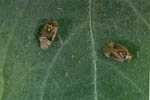The tarnished plant bug attacks potatoes as well as many other field crops, vegetable crops and fruit tree crops including pear, plum, cabbage, carrots, peas, turnips, alfalfa, clover and tobacco.
Identification
The tarnished plant bug attacks potatoes as well as many other field crops, vegetable crops and fruit tree crops including pear, plum, cabbage, carrots, peas, turnips, alfalfa, clover and tobacco.
Identification

The tarnished plant bug is a small, flattened and oval insect with piercing-sucking mouth parts. The adult is about 6 mm long, generally copper colored, mottled with small, irregular patches of white, yellow, reddish-brown and black. A clear yellow triangle is distinguishable on it's back. This triangle is tipped with a small intensely black dot in the center. The nymphs have long legs and long antennae. The immature nymphs are about 1 mm long and yellowish-green. The older nymphs have four black dots on the thorax and one dot at the base of the abdomen.
Life history
The adult hibernates under leaf mold, stones, tree bark, and among the leaves and stems of plants. It becomes active in the spring and attacks the terminal buds of fruit trees. It migrates to various weeds to lay eggs and seems to prefer weeds such as dandelion and chickweed. First generation adults are most abundant on pigweed, lamb's-quarters, plantain and goldenrods. The insect appears on potatoes when these other host plants become too mature.
The life cycle of the tarnished plant bug can be completed in about 4 weeks and two or three generations occur during the course of a growing season. The heaviest infestations are usually observed in mid August.
Crop Injury
Injury may be more pronounced during hot dry weather because the insect will move from dried plants such as weeds onto the adjacent potato crop. As the insect feeds, it introduces a toxin into the plant. The toxin causes potato leaves to deform and wilt and blossoms to drop prematurely.
Pest Management
The tarnished plant bug can easily be monitored in late summer and fall to determine the relative density of overwintering adults. This is achieved by checking weeds in the hedge rows of fields planned for potato production the following spring. Weeds such as goldenrods should be checked.
If adults are found in high numbers, adjacent potato fields should be closely monitored the following year and control measures taken if the insect invades the crop.
Hay fields, especially alfalfa fields, close to potato fields should be checked before the hay crop is harvested. If high numbers are found, the potato crop should be monitored carefully after the hay is harvested. During dry conditions in mid to late summer, potato fields should also be monitored closely.
At present, no thresholds exist for the tarnished plant bug on potatoes.